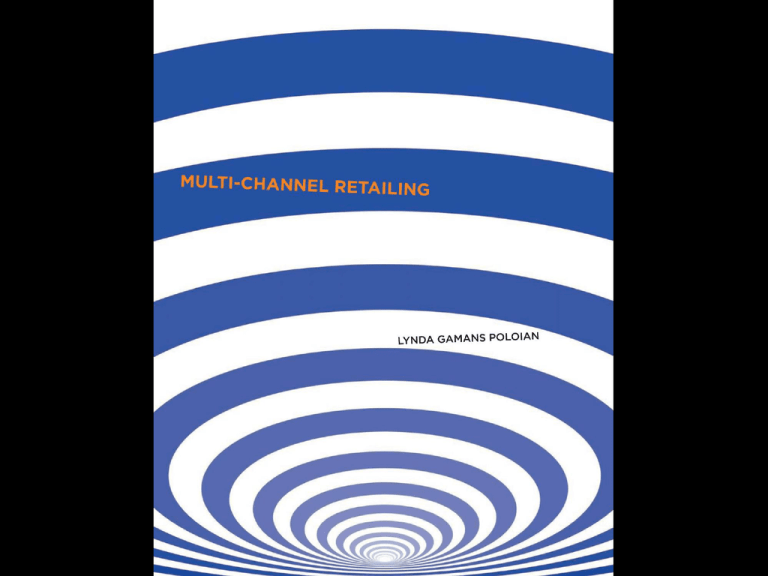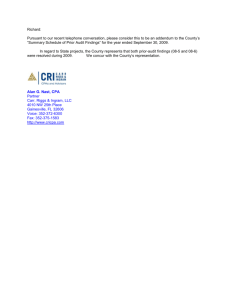
Multichannel Retailing
Lynda Gamans Poloian
Copyright ©2009
Fairchild Books
• All rights reserved. No part of this presentation covered by
the copyright hereon may be reproduced or used in any
form or by any means–graphic, electronic, or mechanical,
including photocopying, recording, taping, or information
storage and retrieval systems–without written permission
of the publisher.
ISBN: 978-1-56367-6332-1
GST R 133004424
Unit I
The Road to Multichannel
Retailing
Chapter 1
Evolution and Impact
Multichannel Retailing Defined:
Electronic and Mobile Methods
• E-retailing—Online and other electronic
transactions involving goods and services for
personal, nonbusiness use
• E-commerce—Includes consumer and business
sectors, encompassing all goods and services sold
on the Internet
• M-commerce—Selling through cell phones and
personal digital assistants that are Internet
equipped
• S-commerce—Selling through social media
• I-commerce---Selling through interactive kiosks
L. Poloian
Chapter 1
5
©2009 Fairchild Books, A Division of Condé Nast Publications.
Multichannel Retailing Defined:
Bricks, Slicks, and Clicks
• Multichannel Retailing Integrates:
– Brick-and-mortar stores (bricks)
– Direct marketing methods: catalogs and direct mail
pieces (slicks)
– Online (clicks)
– And much more!
L. Poloian
Chapter 1
6
©2009 Fairchild Books, A Division of Condé Nast Publications.
Discerning Channels from Vehicles
• Channels—Conduits through which sales
are transacted: ordering online, making a
catalog or store purchase
• Vehicles—Promotions or other techniques
used to reach and inform customers
L. Poloian
Chapter 1
7
©2009 Fairchild Books, A Division of Condé Nast Publications.
Organizational Structures
•
•
•
•
Pure-play—One channel
Dual-channel—Two distinct channels
Multichannel—Two or more channels (triple play)
Electronic spin-offs—Companies that traded through
other electronic means before opening online stores
• Nontransactional sites—Web sites used for
information, not commerce
L. Poloian
Chapter 1
8
©2009 Fairchild Books, A Division of Condé Nast Publications.
Why Adopt Multichannel Retailing?
•
•
•
•
•
•
•
Reach more customers
Provide customer convenience
Compete more effectively
Grow the business
Balance risk
Achieve profitability
Expand globally
L. Poloian
Chapter 1
9
©2009 Fairchild Books, A Division of Condé Nast Publications.
Justification for Multichannel
Retailing
• MCR is a strategic
imperative for growth
• Expands customer
convenience
• Adds retail format
options
• Increases customer
expenditures
L. Poloian
Chapter 1
10
©2009 Fairchild Books, A Division of Condé Nast Publications.
Roots of Multichannel Retailing
Early History and Origins of the Internet:
• 1960s—U.S. Department of Defense
developed ARPAnet
• 1989—World Wide Web developed in
Switzerland
• Early 1990s—Mosaic (first Web browser)
became Netscape Navigator
• 1994—Amazon.com first major pure-play
L. Poloian
Chapter 1
11
©2009 Fairchild Books, A Division of Condé Nast Publications.
Roots of Multichannel Retailing:
Obstacles to Development
•
•
•
•
Economic downturn in 2000-2001and 2010
Bursting of dot-com bubble
Scarcity of money for development
Battles within companies for control and resources
L. Poloian
Chapter 1
12
©2009 Fairchild Books, A Division of Condé Nast Publications.
Roots of Multichannel Retailing:
Current Status
• Multichannel retailing accepted as the norm
• Online sales grow more slowly in economic
downturns and as the industry matures
• Business practices become more efficient
• Customers reached worldwide
• Cyber Monday?
L. Poloian
Chapter 1
13
©2009 Fairchild Books, A Division of Condé Nast Publications.
Impact of Multichannel Retailing:
Worldwide Internet Usage
• 2000—350 million users
• 2005—765 million users
• 2009—1.17 billion users
In 2008 the number of Internet users in
China (253 million) surpassed the U.S. (220
million) for the first time.*
* Sources: China Internet Network Information Center and Neilson Research
L. Poloian
Chapter 1
14
©2009 Fairchild Books, A Division of Condé Nast Publications.
Impact of Multichannel Retailing:
Online Performance Measures
•
•
•
•
•
Revenue growth
Gross Margin or Profitability
Annual sales
Impact of holiday sales periods
Other performance measurements:
–
–
–
–
L. Poloian
Chapter 1
Click-through rates
Shopping cart abandonment rates
Customer service metrics
Web site design evaluation
15
©2009 Fairchild Books, A Division of Condé Nast Publications.
Top Multichannel Retailers:
Online Trends
• In 1999 only 27 of the top 50 online retailers were
multichannel
• In 2009, 41 of the top 50 were multichannel
retailers
• Of the top 10 online retailers only Amazon.com
and Newegg.com were pure-play retailers
L. Poloian
Chapter 1
16
©2009 Fairchild Books, A Division of Condé Nast Publications.
Worldwide Internet Usage:
Penetration Rate
• Penetration rate:
• measures the percentage of the population
that purchases a product or service—not
simply Internet usage
– The highest penetration rates are held by:
• United States
• Japan
• South Korea*
*Source: InternetWorldStats.com
L. Poloian
Chapter 1
17
©2009 Fairchild Books, A Division of Condé Nast Publications.
Top 5 E-retailers for 2009
Rank
Company
Comments
1
Amazon.com
Well diversified product mix;
withstanding economic slump
2
Staples
Expects one-third of sales to come from
Web
3
Office Depot
Using m-commerce features and
customer services
4
Dell
Upgrading customer service in very
competitive market
5
HP
Analyzing customer metrics carefully
Source: Internet Retailer. “Top 500 Guide.” 2008 Edition: p86-94
L. Poloian
Chapter 1
18
©2009 Fairchild Books, A Division of Condé Nast Publications.
Lessons Learned from Top Retailers
• Some perform better than expected
• Sales may not keep pace with technological
advances-Technology is driving retail
• High costs of doing business change selling
channels
L. Poloian
Chapter 1
19
©2009 Fairchild Books, A Division of Condé Nast Publications.
Deployment Strategies
• Some started as brick-and-mortar retailers
and later added online stores (Macy’s)
• Some began as online retailers then added
catalogs and/or stores (Red Envelope)
• Many catalog companies added brick-andmortar and online stores (Sears)
• Depends on the company and its resources
L. Poloian
Chapter 1
20
©2009 Fairchild Books, A Division of Condé Nast Publications.
Factors Shaping the Retail Industry
• Technological Advances
–
–
–
–
–
Hardware, software, gadgets
Social networking
Virtual worlds
Advanced search
Web analytics
• Customer Dynamics
– Aging but active baby boomers
– Technology savvy young
people
– Value consciousness
– Empowered Consumer
L. Poloian
Chapter 1
21
©2009 Fairchild Books, A Division of Condé Nast Publications.
Factors Shaping the Retail Industry
• Industry
Consolidation
– Mergers
– Acquisitions
– Larger companies but
fewer of them
L. Poloian
Chapter 1
• Merchandising
Polarity
– From luxury to lowbudget goods
– Assortments seem
fragmented
– Wide variety of
consumers
22
©2009 Fairchild Books, A Division of Condé Nast Publications.
Factors Shaping the Retail Industry
• Supply Chain Initiatives
– Shorter merchandise
production cycles-QR
– Faster time to market
– EDI
– Greater use of Web for
design and production-CAD
– Growth of RFID
technology
L. Poloian
Chapter 1
• Global Retail Expansion
– Globalization continues
– Business and non-business
sectors affected
– Many global challenges
including the economy
23
©2009 Fairchild Books, A Division of Condé Nast Publications.
Factors Shaping the Retail Industry
• Emergence of China
– Major power shift
– Chief exporter to the U.S.
and the world
– Human rights and
intellectual property issues
– Retail activity and growth
– Inflation
– Huge disparity between real
China and new consumer
L. Poloian
Chapter 1
24
©2009 Fairchild Books, A Division of Condé Nast Publications.
Factors Shaping the Retail Industry
• Multichannel Emphasis
– Significant influence on retailing today
– Emphasis on integration across channels
– Huge potential if done correctly
L. Poloian
Chapter 1
25
©2009 Fairchild Books, A Division of Condé Nast Publications.
Factors Shaping the Retail Industry
• Organized Retail Crime
– Major negative movement
– Involves groups of people
engaging in theft and scams
– Copyright infringement
– Counterfeit
– Significant losses to
retailers
L. Poloian
Chapter 1
• Customer Privacy and
Security
– Capture and use of personal
data concerns customers
– Data breaches causing ID
theft
– Phishing online
– Spam
26
©2009 Fairchild Books, A Division of Condé Nast Publications.
Factors Shaping the Retail Industry
• Sustainability
– Growing interest in
environment by retailers
and consumers
– Retailers involved in ecofriendly building products
and utilities
– Concerns about carbonneutral emissions
– Renewable fibers and
materials
– Sustainable Practices
– Index
L. Poloian
Chapter 1
27
©2009 Fairchild Books, A Division of Condé Nast Publications.
Summary
• Multichannel retailing:
• creates more value and options for
customers
• fuels growth for proactive retailers
• Adds management challenges
• Requires consistency and message
integration
• Platform Integration
L. Poloian
Chapter 1
28
©2009 Fairchild Books, A Division of Condé Nast Publications.





